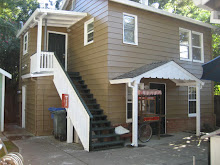
Kentucky Bluegrass is perennial with a widely creeping rootstock. This produces runners and leafy shoots. The runners are underground stems, carrying colourless scales instead of green leaves. They creep under the surface of the ground, rooting from the joints and finally producing upright, leafy stems from their ends. The leafy shoots are upright from the beginning and arise in bunches from the very base of the stems. They are round and have at first only leaves but develop later into flower-bearing stems. The stems are from one-half to three feet high, perfectly smooth. The stem leaves are comparatively short, only one or two inches long, and their apex is contracted somewhat after the fashion of the end of a canoe. The leaves of the basal shoots are longer and generally narrower than the stem leaves. Although showing considerable variation in colour, shape and size, the leaves have always this characteristic in common, that the ligule is very short and blunt. The flowers are in a panicle, pyramidal in shape during blossoming time and afterwards more or less contracted. Each branch of the panicle carries several spikelets. These are generally bluish - green-hence the name Blue Grass - but sometimes they have a purplish or violet shade. A spikelet has as a rule four or five flowers, each of which is enclosed within two glumes of equal size. Although the arrangement of stamens and pistils indicates that cross-fertilization would be easy, no doubt much self-fertilization takes place.
http://chestofbooks.com/flora-plants/weeds/Fodder-Pasture-Plants/Kentucky-Blue-Grass-Poa-Pratensis-L.htmlModerate to high quality depending on cultivar, management, and environment; medium texture; green to dark green with good density.
http://www.purdue.edu/envirosoft/lawn/src/grass/midwest.htm
